

Untitled. Machine Learning for Humans, Part 5: Reinforcement Learning. Exploration and exploitation.
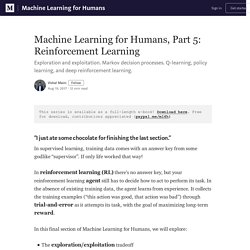
Markov decision processes. Q-learning, policy learning, and deep reinforcement learning. This series is available as a full-length e-book! Download here. Free for download, contributions appreciated (paypal.me/ml4h) “I just ate some chocolate for finishing the last section.” In supervised learning, training data comes with an answer key from some godlike “supervisor”. In reinforcement learning (RL) there’s no answer key, but your reinforcement learning agent still has to decide how to act to perform its task.
In this final section of Machine Learning for Humans, we will explore: The exploration/exploitation tradeoffMarkov Decision Processes (MDPs), the classic setting for RL tasksQ-learning, policy learning, and deep reinforcement learningand lastly, the value learning problem At the end, as always, we’ve compiled some favorite resources for further exploration. This brings up the exploration/exploitation tradeoff. Simple Reinforcement Learning with Tensorflow Part 0: Q-Learning with Tables and Neural Networks. For this tutorial in my Reinforcement Learning series, we are going to be exploring a family of RL algorithms called Q-Learning algorithms.
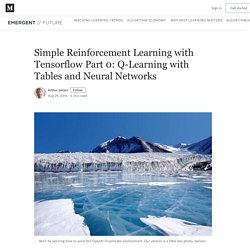
These are a little different than the policy-based algorithms that will be looked at in the the following tutorials (Parts 1–3). Instead of starting with a complex and unwieldy deep neural network, we will begin by implementing a simple lookup-table version of the algorithm, and then show how to implement a neural-network equivalent using Tensorflow. Given that we are going back to basics, it may be best to think of this as Part-0 of the series. Machine Learning na AWS. Fast AI Video Viewer. You can click the blue arrow buttons on the left and right panes to hide them and make more room for the video.
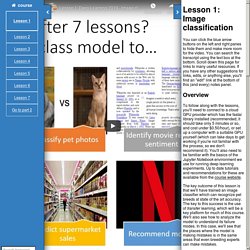
You can search the transcript using the text box at the bottom. Scroll down this page for links to many useful resources. If you have any other suggestions for links, edits, or anything else, you'll find an "edit" link at the bottom of this (and every) notes panel. Overview To follow along with the lessons, you'll need to connect to a cloud GPU provider which has the fastai library installed (recommended; it should take only 5 minutes or so, and cost under $0.50/hour), or set up a computer with a suitable GPU yourself (which can take days to get working if you're not familiar with the process, so we don't recommend it).
The key outcome of this lesson is that we'll have trained an image classifier which can recognize pet breeds at state of the art accuracy. We'll discuss the overall approach of the course, which is somewhat unusual in being top-down rather than bottom-up. Links. Deep Learning/AI with AMD GPU’s : Amd. Practical Deep Learning for Coders, v3. Which GPU(s) to Get for Deep Learning. AWS training and certification. Free Courses & Tutorials. Dimitri korobchenko. “How to accelerate your neural net inference with TensorRT”, Dmitry Korobchenko. 1512.03385. Deep Learning World 2019 - the premier conference. Towards Data Science. Introduction to Machine Learning How to install NGINX + PHP7.1 + PHP-FPM in Amazon AMI EC2 for LARAVEL 5.x. No blah blah blah, let’s go to the point…
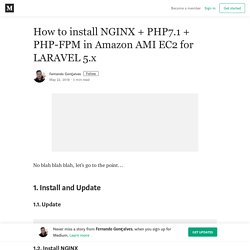
Facebook’s A.I. Whiz Now Faces the Task of Cleaning It Up. Sometimes That Brings Him to Tears. “We can now catch this sort of thing — proactively,” Mr.
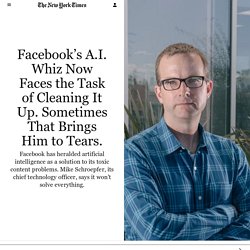
Schroepfer said. The problem was that the marijuana-versus-broccoli exercise was not just a sign of progress, but also of the limits that Facebook was hitting. Mr. Schroepfer’s team has built A.I systems that the company now uses to identify and remove pot images, nudity and terrorist-related content. But the systems are not catching all of those pictures, as there is always unexpected content, which means millions of nude, marijuana-related and terrorist-related posts continue reaching the eyes of Facebook users. Identifying rogue images is also one of the easier tasks for A.I. Delip Rao, head of research at A.I. “Sometimes you are ahead of the people causing harm,” Mr. On that afternoon, Mr. Mr. In designing systems that identify graphic violence, Facebook typically works backward from existing images — images of people kicking cats, dogs attacking people, cars hitting pedestrians, one person swinging a baseball bat at another.
TR EB tensorflow. Human-Centered AI & Autonomous Vehicles. An in-depth look at Google’s first Tensor Processing Unit (TPU) Taking a Systems Approach to Adopting AI. Executive Summary To scale the benefits of AI-innovations, companies need to stop thinking of AI tools and applications — such as natural language processing or computer vision — as standalone solutions.
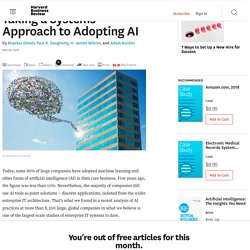
Otherwise, the opportunity cost could be as large as 41% of revenue by 2023. Companies that see AI as components of next-generation enterprise IT systems stand to grow revenues by as much as one-third over the next five years. And as systems evolve, so must the IT workforce. Companies will need multidisciplinary talent that can bridge infrastructure, development tools, programming languages, AI, and machine learning. H2O.ai. Deep Learning World 2019 - the premier conference - Workshops - Deep Learning in Practice: A Hands-On Introduction. An in-depth look at Google’s first Tensor Processing Unit (TPU) Intro to TensorFlow for Deep Learning. Pearltrees – Get this Extension for □ Firefox (en-US)